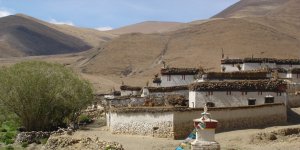| Published in Destinations |
Băile Olănești, a Spa Town in Romania
DANIEL ŞTEFĂNIŢĂ
Located in Vâlcea County, about 200 kilometers northwest of Bucharest, Băile Olănești is a charming spa town that has been attracting visitors for centuries with its healing mineral waters and serene mountain setting.
The mineral waters in Băile Olănești have been studied for their health benefits and recognized for their value in treating renal lithiasis; they were mentioned for the first time in a 1760 charter and were called “healing waters.” The first testing of these waters was made by Dr. Carl Friedrich Siller in 1830. 1

Băile Olănești. Photo: D. Stefanita
Visitors to Băile Olănești can enjoy a variety of spa treatments, including hydrotherapy, mud baths, and inhalation therapy. The town's sanatoriums and health centers combine traditional balneotherapy techniques with modern medical approaches, offering a holistic healing experience.
Beyond its spa facilities, the town charms visitors with its beautiful natural surroundings. North of the town are Căpățânii Mountains, that provide ample opportunities for hiking, nature walks, and outdoor recreation. The clean mountain air and lush forests contribute to the overall sense of wellbeing that permeates the area.

Buila-Vânturarița Mountains seen from Tisa village. The altitude of Vârful Buila is 1849 meters. Photo: D. Stefanita
Despite its long history and remarkable natural resources, Băile Olănești remains somewhat of a hidden gem in European spa tourism. This relative obscurity allows the town to maintain its peaceful atmosphere and authentic Romanian charm, making it an ideal destination for those seeking a truly restorative and culturally enriching experience.
There are several springs rich in calcium2 and magnesium,3 which are more bioavailable than those found in dietary supplements. Regular consumption (1.5-2 liters per day) of these waters is not associated with an increased risk of stone formation when medical advice is followed.
These waters can influence urinary chemistry by increasing the excretion of citric acid and reducing the excretion of oxalic acid. This helps lower the saturation levels of calcium oxalate and uric acid in urine, thereby potentially preventing the formation of stones.
In addition to internal consumption for kidney stone prevention, these mineral waters are also used for treating other conditions such as nephritis and pielitis due to their diuretic and anti-inflammatory properties.
Table 1: Water Chemical Analysis of four wells.4
| Well #: | 10 | 12 | 5 | 24 | |
| Units: | mg/L | mg/L | mg/L | mg/L | |
| Temp - Celsius | 9.5 | 8.0 | 9.5 | 10.5 | |
| PH (>7 = alkaline) | 7.6 | 7.6 | 7.4 | 7.6 | |
| Chlorine | Cl | 120.5 | 28.4 | 3049.3 | 28.4 |
| Bromine | Br | 1.2 | |||
| Iodine | I | 1.0 | |||
| Nitrate | NO3 | 2.4 | |||
| Nitrite | NO2 | 0.1 | 0.1 | ||
| Sulphates | SO4- | 172.0 | 272.8 | 52.5 | 264.2 |
| Bicarbonic | HCO3- | 390.4 | 390.4 | 317.2 | 329.4 |
| Carbonates | CO3 | ||||
| Sodium | Na+ | 160.9 | 174.8 | 1847.6 | 150.4 |
| Potassium | K+ | 7.0 | 3.0 | 11.0 | 3.0 |
| Ammonium | NH+4 | ||||
| Calcium | Ca2+ | 70.5 | 52.9 | 137.8 | 37.7 |
| Magnesium | Mg2+ | 33.1 | 31.1 | 58.3 | 38.9 |
| Iron | Fe2+ | 0.1 | 0.1 | ||
| Manganese | Mn2+ | ||||
| Metasilicic acid | H2SiO3 | 18.8 | 10.4 | 11.4 | 11.7 |
| Metaboric acid | HBO2 | 7.0 | 28.3 | 77.9 | 7.0 |
| Organic Substances | O2 | 1.0 | 1.2 | 1.6 | 1.2 |
| Carbon dioxide | CO2 | ||||
| Hydrogen sulphide | H2S | 5.8 | 2.5 | 14.6 | 3.2 |
Chemical compositions shown at each well location.
Sources
• https://en.wikipedia.org
• https://www.olanesti-romania.ro
• https://www.ncbi.nlm.nih.gov/pmc/articles/PMC5318167
• https://pubmed.ncbi.nlm.nih.gov/9096270
Footnotes
1. Carl Siller was a professor of Pharmacy at Dorpat University, 1843-1850. Born in Danzig, Germany, in 1801, he immigrated to Milwaukee, Wisconsin in 1850.
2. While calcium can form stones, the presence of calcium (Ca²⁺) in these waters can paradoxically help by binding with oxalate (C₂O₄²⁻) in the intestines, reducing oxalate absorption into the bloodstream. This leads to lower oxalate levels in the urine, decreasing the chances of calcium oxalate stones forming.
3. Magnesium (Mg²⁺), present in the mineral waters, interacts with oxalate (C₂O₄²⁻) ions in the digestive tract and urine, forming magnesium oxalate, which is more soluble than calcium oxalate (CaC₂O₄), the most common component of kidney stones. This reduces the amount of oxalate available to combine with calcium: Mg²⁺+C₂O₄²⁻→MgC₂O₄ (soluble).
4. The mineral composition of these waters suggests potential health benefits related to digestion, cardiovascular health, and bone strength due to high levels of bicarbonate, calcium, magnesium, and potassium. However, attention should be paid to sodium levels for individuals with hypertension or heart conditions. Regular consumption should be balanced with awareness of individual health conditions and dietary needs.
YOU MAY ALSO LIKE






 If you own or manage a travel-related business such as a hotel, a bed-and-breakfast, a restaurant, a pub or a cafeteria, you can create a web page for your business for free on Titi Tudorancea Travel Info. » |